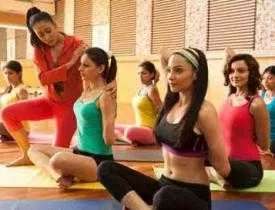Description
Course Name: Diploma in Fitness Cum Yoga Trainer
Course Id: DFCYT/Q001.
Education Qualification: 10th Pass.
Duration: 370 Hrs.
How You will Get Diploma Certificate:
Step 1- Select your Course for Certification.
Step 2- Click on Enroll Now.
Step 3- Proceed to Enroll Now.
Step 4- Fill Your Billing Details and Proceed to Pay.
Step 5- You Will be Redirected to Payment Gateway, Pay Course and Exam Fee by Following Options.
Card(Debit/Credit), Wallet, Paytm, Net banking, UPI and Google pay.
Step 6- After Payment You will receive Study Material on your email id.
Step 7- After Completion of Course Study give Online Examination.
Step 8- After Online Examination you will get Diploma Certificate soft copy(Scan Copy) and Hard Copy(Original With Seal and Sign).
Step 9- After Certification you will receive Prospect Job Opportunities as per your Interest Area.
Online Examination Detail:
- Duration- 120 minutes.
- No. of Questions- 60. (Multiple Choice Questions).
- 10 Questions from each module, each carry 10 marks.
- Maximum Marks- 600, Passing Marks- 40%.
- There is no negative marking in this module.
| How Students will be Graded: | ||
| S.No. | Marks | Grade |
| 1 | 91-100 | O (Outstanding) |
| 2 | 81-90 | A (Excellent) |
| 3 | 71-80 | A (Very Good) |
| 4 | 61-70 | B (Good) |
| 5 | 51-60 | C (Average) |
| 6 | 41-50 | P (Pass) |
| 7 | 0-40 | F (Fail) |
Benefits of Certification:
- Government Authorized Assessment Agency Certification.
- Certificate Valid for Lifetime.
- Lifetime Verification of Certificate.
- Free Job Assistance as per your Interest Area.
Syllabus
Diploma in Fitness Cum Yoga Trainer
Yoga and Yogic Texts
Introduction to yoga, Objectives of Yoga, Yoga: meaning and initiation, Misconceptions about Yoga, Basis of Yoga, Origin and history of development of Yoga: Psychological aspects leading to origin of Yoga, Vedic period, Pre-classical period, Classical period, Yoga in medieval times, Raja Yoga and Ashtang Yoga: Aims and objectives of Yoga, Yogic practices: Do’s and Don’ts, streams of Yoga, schools of Yoga, Yogic practices for healthy living, Historicity of Yoga as a discipline, Classification of Yoga and Yogic texts, Yoga sutra of Patanjali, Hath Yoga texts, Hath yoga practices: Asanas, Pranayama, Dharana on five elements, Mudras and bandhas, Shatkarma, the set of six cleansing techniques, Relationship between patanjali Yoga and Haṭha Yoga, Meditational processes in Patanjali Yoga Sutra, Relation of Yoga with Physiology and Psychology.
Ashtang Yoga
Introduction to Ashtang yoga, Objectives of yoga, Advantage and disadvantages, Characteristics Of Ashtang Yoga, Stages Of Ashtang Yoga, Benefits Of Yoga And their Types, Element of Yoga, Awakening The Fire Within: Vinyasa, Movement Breathing System, Access All Areas, Alain Danielou, Feeding The Fire: The Breath Of Life, Ujjayi Breathing, Prana, The Chakras: Muladhara, Svadhisthana, Anahata, Chakra Contemplation, Yamas, Niyamas, Limbs of Yoga, Asanas, Pranayama, Pratyahara, Dharana, Dhyana, Samadhi, Cleansing And Purification, Characteristics Of Ashtang Yoga, Classes , father of yoga, Concepts Of yoga, Series of Ashtang Yoga.
Yogic Culture and Value Education
Concept and meaning of Yoga and its form, Definition of Culture and Civilization, Salient Characteristics of Indian and Western Culture, Yoga as basis of Culture and Humanitarianism, Values: meaning, significance, classification; Indian Understanding of Values, Basis of Value Development: Socio-cultural, Psychological, Concept of Value Education: Meaning, aims and objectives, Rationale of Value Education, Contents of Value Education and Role of Teachers, Methods of Value Education: Yoga as a method of Value Education, Implication & application of Value Education in one’s own life style.
Human Anatomy and Physiology
Introduction to Anatomy, Advantages and Disadvantages of Human Anatomy, Principal of Anatomy, Introduction to Human Anatomy and Energy System, Skeletal System and Muscular System, Respiratory System, Cardiovascular System, Principal of Physiology : Muscular System, Energy System, Exercise Related Physiological Changes, Practical Exercise Training, Cardio/Aerobic Training (Continuous Training, Interval Training, Fartlek Training, Circuit Training and Aerobic Cross Training), Resistance/Weight Training, Traditional Methods of Fitness Training, Thera ball Training, Concept of Living body and stages of life – modern view, Concept of Anatomy & Physiology and its importance in Yogic field, Modern History of Scientific concept about yogic practices, Structural organization of body, Concept of harmony in related with health.
Yogic Diet and Shatkarma
Introduction of Ahara (Diet), concept of Mitahara; Definition and Classification in Yogic diet according to traditional Yoga texts; Concepts of Diet according to Gheranda Samhita, Hatha Pradeepika and Bhagavadgeeta-Rajasic, Tamasic and Sattvic food; Pathya and Apathya in diet according to Yogic texts; Guna and Ahara; Importance of Yogic Diet in Yoga Sadhana; Yogic Diet and its role in healthy living; Diet according to the body constitution (Prakriti) – Vata, Pitta and Kapha. Meaning of shatkarma.
Yoga Asanas, Pranayamas and Meditation
Meaning of yoga Asanas, Benefits, View of traditional text, scientific view, Types of Asanas, Anatomy, physiology, therapeutic importance & limitation of various Asanas described in traditional texts, Asana- How to use as a therapy, psycho-physiological effect, Various types according to traditional texts and their importance, Therapeutic importance and research about Pranayama, Scientific view, Types and variation, As a means & Goal/End, Types and variations, Concept of Body Mind and beyond mind, Conceptual understanding of body mind & beyond with reference to human body function.







